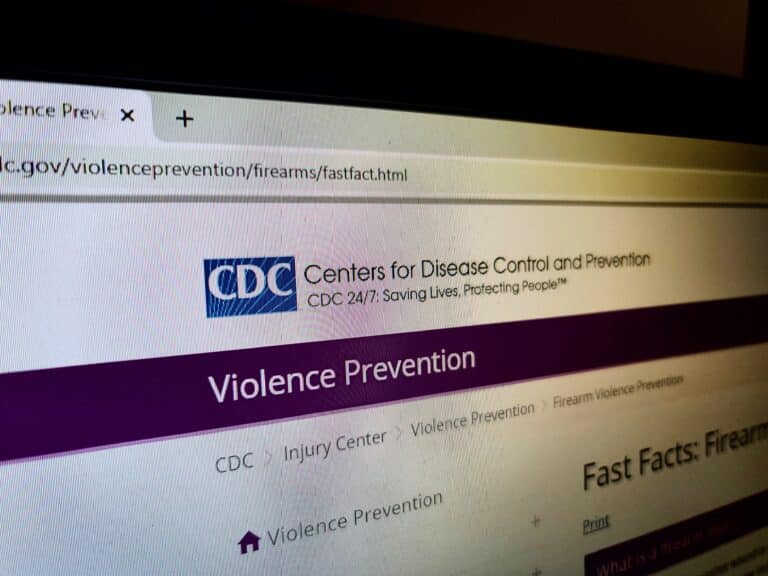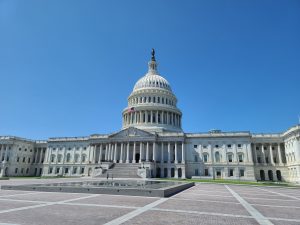The Centers For Disease Control (CDC) deleted a reference to a study it commissioned after a group of gun-control advocates complained it made passing new restrictions more difficult.
The lobbying campaign spanned months and culminated with a private meeting between CDC officials and three advocates last summer, a collection of emails obtained by The Reload show. Introductions from the White House and Senator Dick Durbin’s (D., Ill.) office helped the advocates reach top officials at the agency after their initial attempt to reach out went unanswered. The advocates focused their complaints on the CDC’s description of its review of studies that estimated defensive gun uses (DGU) happen between 60,000 and 2.5 million times per year in the United States–attacking criminologist Gary Kleck’s work establishing the top end of the range.
“[T]hat 2.5 Million number needs to be killed, buried, dug up, killed again and buried again,” Mark Bryant, one of the attendees, wrote to CDC officials after their meeting. “It is highly misleading, is used out of context and I honestly believe it has zero value – even as an outlier point in honest DGU discussions.”
Bryant, who runs the Gun Violence Archive (GVA), argued Kleck’s estimate has been damaging to the political prospects of passing new gun restrictions and should be eliminated from the CDC’s website.
“And while that very small study by Gary Kleck has been debunked repeatedly by everyone from all sides of this issue [even Kleck] it still remains canon by gun rights folks and their supporting politicians and is used as a blunt instrument against gun safety regulations every time there is a state or federal level hearing,” he wrote in the same email. “Put simply, in the time that study has been published as ‘a CDC Study’ gun violence prevention policy has ground to a halt, in no small part because of the misinformation that small study provided.”
Despite initially standing behind the description in the defensive gun use section of its “fast facts” website on gun violence, the CDC backtracked after a previously-undisclosed virtual meeting with the advocates on September 15th, 2021.
“We are planning to update the fact sheet in early 2022 after the release of some new data,” Beth Reimels, Associate Director for Policy, Partnerships, and Strategic Communication at the CDC’s Division of Violence Prevention, said in one email to the three advocates on December 10th. “We will also make some edits to the content we discussed that I think will address the concerns you and other partners have raised.”
The CDC did not respond to a request for comment on the decision, but none of the emails the agency released related to it did not show any attempts to obtain other outside points of view either before or after the meeting with the gun-control advocates. Hannah Bristol of the White House Office of Public Engagement did not respond to a request for comment on her role in the discussions beyond what the emails reveal. Emily Hampsten, Senator Durbin’s Communications Director, told The Reload their office’s only involvement was “simply connecting” “stakeholder organizations” with a federal agency as part of the “basic function of our work.”
The decision to remove a CDC-commissioned report from the agency’s website on gun statistics at the apparent behest of gun-control advocates may further strain its relationship with Congressional overseers, especially pro-gun Republicans who are set to take control of the House next year. The relationship between the two, already frayed over the Coronavirus pandemic, could reach new lows not seen in decades. During the 1990s, Congress put restrictions on CDC funding in response to officials openly working with gun-control groups to try and ban handguns.
“We need to revolutionize the way we look at guns, like what we did with cigarettes,” Mark Rosenberg, director of the CDC’s National Center for Injury Prevention, told The Washington Post in 1994. “It used to be that smoking was a glamour symbol–cool, sexy, macho. Now it is dirty, deadly–and banned.”
Kleck, Professor Emeritus at Florida State University’s College of Criminology and Criminal Justice, stood by his research. He said the CDC did not reach out to him for his perspective before making the change. He argued the removal of the reference to his estimate was “blatant censorship” and said it was evidence of the politicization of the agency.
“CDC is just aligning itself with the gun-control advocacy groups,” Kleck told The Reload. “It’s just saying: ‘we are their tool, and we will do their bidding.’ And that’s not what a government agency should do.”
The website change and the fact that it resulted from a lobbying campaign were first reported by The Trace earlier this year. The publication identified Bryant’s involvement and that of Devin Hughes, who runs GVPedia. The new emails revealed through a Freedom of Information Act (FOIA) request filed by Konstadinos Moros, a lawyer representing the California Rifle & Pistol Association, showed the nature of that lobbying and the involvement of Newtown Action Alliance chairwoman Po Murray.
Bryant and GVA have gained notoriety for its count of “mass shootings” that uses a much broader definition, with any shooting where four or more victims are injured compared to the Associated Press definition of four or more killed. The difference in methodology results in a near-ten-fold difference in the number of identified “mass shootings.” GVA’s count, alongside its near-real-time tracking of shootings through media reports, has been widely cited by media outlets since it was launched in 2013.
Conversely, GVA uses the most conservative criteria for what constitutes a defensive gun use. Instead of attempting to capture any time a person legally uses a gun to defend themselves or others, it only counts incidents that make it into media reports or police reports (though it’s unclear how many police reports they have access to). The site’s methodology takes a strikingly dismissive tone towards any other potential defensive gun uses.
“Our policies do not take into account stories not reported, ‘I can’t believe this happened to me’ scenarios or extrapolations from surveys,” the methodology reads. “Our position is that if an incident is significant enough that a responsible gun owner fears for their life and determines a need to threaten lethal force it is significant enough to report to police so law enforcement can stop that perpetrator from harming someone else.”
While GVA’s stated goal is to provide “unbiased, unfiltered data on gun violence in America,” Bryant described a different motivation in lobbying the CDC to remove the link to its own paper on defensive gun uses.
“Until proof if (SIC) available we in the GVP community respectfully request that this outlier that has been used so often to stop legislation be removed until a panel can build a fair survey which will better reflect the true status of the number of DGUs,” he told the CDC in his follow up email after their meeting.
Similarly, GVPedia’s website says its mission is to “provide ready access to academic research and high quality data on gun violence.” But Hughes and his organization also equates gun ownership with smoking and drunk driving. Further, it endorses and advocates for legislation aimed at restricting gun ownership. They also share controversial political messages on the organization’s Twitter, including a recent cartoon accusing the National Rifle Association and Republicans of reveling in a bloody massacre.
While Bryant and Hughes have produced gun violence research, Po Murray is a more traditional activist. Despite the CDC saying it had only heard from “a few members of the gun research community who expressed concern about the original fact sheet content” in a statement it drafted for but never sent to The Trace, Murray was the one who facilitated the entire conversation through her contacts in the White House and Senator Durbin’s office.
Murray and Newtown Action Alliance are among the most bombastic members of the gun-control activist space. They commonly attack anyone opposed to bans on AR-15s or other firearms as supporters of mass shootings. At various points, they have accused everyone from Congressional Republicans to Senate Democrats to Disney to even a father who lost his daughter in the Parkland shooting of supporting the murder of children or wanting to arm killers.
“There is no gray area after a decade of mass shootings,” Murray tweeted in November. “AR15s are the weapons of choice for mass shooters. If you don’t support an assault weapons ban then you support arming mass shooters.”
The three advocates met with CDC Acting Principal Deputy Director Deb Houry, Associate Director of Science for the Division of Violence Prevention Tom Simon, and Associate Director for Policy, Partnerships, and Strategic Communication Beth Reimels. The half-hour meeting was conducted over Microsoft Teams, but a transcript of the call either wasn’t kept or wasn’t turned over as part of the FOIA request. The CDC did not respond to questions about what was said during the meeting.
The meeting came after an email back and forth between the advocates and CDC officials that zeroed in on critiques about Kleck’s scholarship. Hughes argued Kleck’s widely-publicized finding that there are upwards of 2.5 million defensive gun uses per year is “criminologically impossible” based on critiques that mirror those he’d been making in public since a 2015 dispute between he and Kleck played out in the pages of Politico. They focus largely on the discrepancy between the millions of DGUs per year found by Kleck and numerous other estimates based on surveys of Americans and the 2,000 or fewer tallied by Bryant’s Gun Violence Archive.
However, the FOIAd emails show CDC officials rebuffed the criticisms as insubstantial.
“We stand behind our fact sheet,” Linda Dahlberg, a senior advisor to the director of the Divison of Violence Prevention, told Reimels during an internal discussion on how to respond to Hughes in August 2021, “which essentially points out that estimates of defensive gun use vary depending on the data source, questions asked, populations studied, timeframes, and other factors related to the design of studies.”
She cited a dozen different studies on defensive gun uses. She noted GVA’s estimates represent another possible source but one that would miss cases “that may not ever be reported to official sources like law enforcement.”
A statement from the CDC sent to Murray and Hughes by the White House’s Hannah Bristol mirrored Dahlberg’s message. It thanked them for the input but noted the GVA numbers represent “a very small subset of people who have used guns defensively” and “an update is not warranted at this time” for the website’s language.
However, Bristol also added CDC Acting Principal Deputy Director Deb Houry to the thread for any potential follow-ups. When Hughes insisted the GVA numbers disprove Kleck’s larger estimate of defensive gun uses, Houry agreed to set up a meeting with him and Murray. Bryant then asked to be included as well.
Even after the meeting was agreed to, some CDC officials expressed confusion about how there could be a problem with the agency’s description of defensive gun uses. James Mercy, another researcher in the Division of Violence Prevention, noted the description didn’t endorse any particular estimate and merely referred to a CDC-commissioned review of scholarship on the topic.
“I mean all we say on the fact sheet essentially is that you get different estimates of defensive gun use depending on the methods you use to measure it and then point to the National Academy report,” he wrote to Reimels. “Hard to argue against that. What do you think the concern is with this? Or is it something else?”
Mercy also expressed surprise that Bryant was associated with Newtown Action Alliance.
“A few of just met with the CEO of the Gun Violence Archive yesterday – Mark Bryant,” he wrote. “Odd that they would be connected to the Newtown Action Alliance!”
The CDC attempted to redact Mercy’s comment about the tie between GVA and the gun-control group, but it only applied the redaction to one of the several copies of the exchange included in the release. (The agency also failed to redact the emails and phone numbers of many of those included in the release. The Reload has redacted the non-public contact information that was left exposed.)
The released emails do not include any response to Mercy’s questions on why the change would be justified. Some of the FOIAd emails also show officials setting up plans to talk about potential changes “off-line.” Additionally, 18 of the 131 pages released by the CDC were completely redacted.
The CDC and Po Murray did not respond to questions about what was said in the September 15th meeting. Devin Hughes did not provide insight into details of the conversation either, but GVPedia said he voiced his opinion on the reliability of Kleck’s research to the agency.
“The CDC is a trusted and reliable source for many Americans so GVPedia and others reached out to researchers at the CDC to provide more recent, accurate, and reliable data,” Alicia Curran, who spoke on behalf of GVPedia, told The Reload. “We appreciate the CDC’s commitment to removing outdated information and providing the public with a more accurate picture of the research.”
Mark Bryant, who emphasized he is a gun owner and not “anti-gun,” did not provide specific details on what was said during the meeting. However, he said the purpose of his conversation with CDC officials was to make the agency’s website more accurate in his view.
“The purpose was to find a solution to the fast facts sheet that would insure that only accurate, vetted, and verifiable data be included, not extrapolations as they have proven to be extremely unreliable [just look at the numerical spread of the different DGU survey results],” Bryant told The Reload. “The reasons were not to eliminate the discussion of DGUs [that is an important sub-discussion in the gun violence debate space], instead ensure that what was on CDC’s page was accurate and verifiable. In other words, make sure every DGU that is reported is counted but that DGUs which are not provable are not. Nobody benefits from inaccurate data.”
Ultimately, the CDC did offer a justification for the change in the response it drafted for The Trace’s 2022 inquiry but never sent. The agency said it removed the range of DGU estimates and link to its review of research to offer clarity on the issue because the “very wide range” might “raise more questions than it answered.”
“Because estimates of defensive gun use vary depending on the questions asked, populations studied, timeframe, and other factors related to study design, and given the wide variability in previous estimates and the desire to keep the fact sheet short and succinct,” the agency planned to tell the publication, “it made the most sense to remove the numbers from the fact sheet and acknowledge that additional research is necessary to understand defensive gun use prevalence, frequency, circumstances, and outcomes.”
Kleck said he doesn’t buy the CDC’s explanation, though.
“The justification for keeping any defensive gun use estimates out in order to keep a fact sheet succinct, it’s just another way of saying we can’t afford to even put one sentence in about the most frequent violence-related use of firearms,” he told The Reload. “That the factsheet is not in any way harmed by including this fact.”
He argued the real purpose of removing the estimates and link to further reading on the topic would result in further confusion for people who visit the site–something he said was the goal of the advocates who lobbied for its deletion.
“You can’t understand any significant aspects of the gun-control debate once you eliminate defensive gun use,” he said. “It becomes inexplicable why so many Americans oppose otherwise perfectly reasonable gun-control measurements. It’s because they think it’s gonna lead to prohibition, and they won’t have a gun for self-defense.
“It’s not complicated.”
UPDATE 9:25 AM EASTERN 12-20-2022: This piece has been corrected to show that while the CDC drafted a response to The Trace, it never actually sent it to the publication. This piece has also been updated to include comment from Mark Bryant.






